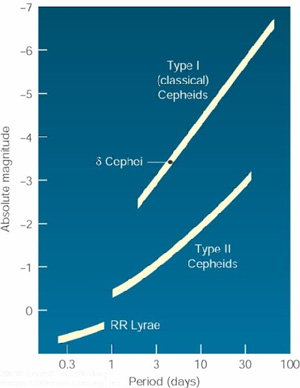Cepheid Variable Stars

Cepheid variables are pulsating variable stars similar to the RR Lyraes mentioned earlier on the distance modulus page. However, Cepheids have longer pulsation periods and they are larger stars. Cepheids have been extremely important as distance indicators for many years. Although they don’t all have the same average absolute magnitude as RR Lyraes do, they are more useful since they are brighter stars and can be observed at greater distances.
Henrietta Leavitt in 1912 was the first to recognize that there was a relationship between the pulsation periods and the luminosities of Cepheids. She recognized that larger, brighter Cepheids have longer pulsation periods, although she was unaware of the exact relationship. Harlow Shapley later calibrated the Cepheids – relating the periods of pulsation to the absolute magnitudes which led to the first estimate of the size of the Milky Way. The calibration of the period-luminosity relationship has improved over time and a modern version is depicted in the figure to the right.

To the left is a graph of the periodicity of the Type I (high-metallicity) Cepheid variable S Nor. Cepheid S Nor has a period of pulsation of approximately 10 days and an average apparent magnitude mV = 6.5, what is its distance? We can use the pulsation period to estimate the absolute magnitude of the Cepheid. From the chart above a period of 10 days corresponds to an absolute magnitude of -4. Thus, the distance modulus is m - M = 6.5 - (-4) = 10.5, which corresponds to a distance of 1260 pc. Note that our estimate is not particularly accurate since we didn’t take into account many subtleties that research astronomers would consider.
Because of the brightnesses of Cepheids, astronomers can identify them in nearby galaxies. Observations of Cepheids by the Hubble Space Telescope have recently been used to estimate the distance to the Virgo Cluster which is about 18 Mpc away.